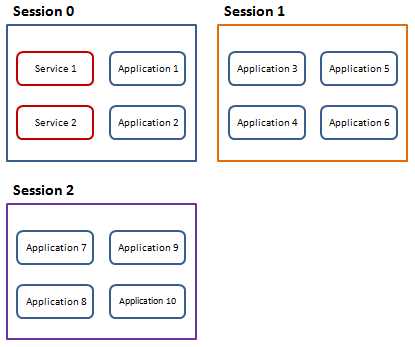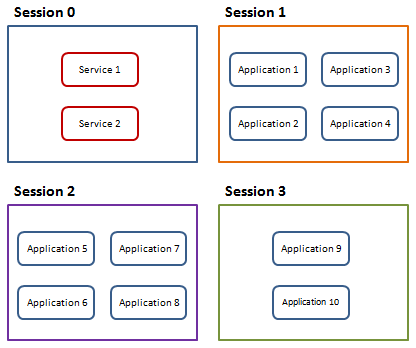C#/.NET基于Topshelf创建Windows服务的系列文章目录:
C#/.NET基于Topshelf创建Windows服务程序及服务的安装和卸载 (1)
在C#/.NET应用程序开发中创建一个基于Topshelf的应用程序守护进程(服务) (2)
C#/.NET基于Topshelf创建Windows服务的守护程序作为服务启动的客户端桌面程序不显示UI界面的问题分析和解决方案 (3)
前言在上一篇文章《在C#/.NET应用程序开发中创建一个基于Topshelf的应用程序守护进程(服务)》的最后,我给大家抛出了一个遗留的问题--在将TopshelfDemoService程序作为Windows服务安装的情况下,由它守护并启动的客户端程序是没有UI界面的。到这里,我们得分析为什么会出现这个问题,为什么在桌面应用程序模式下可以显示UI界面,而在服务模式下没有UI界面?
分析问题(Session 0 隔离)通过查阅资料,这是由于Session 0 隔离作用的结果。那么什么又是Session 0 隔离呢?
在Windows XP、Windows Server 2003 或早期Windows 系统时代,当第一个用户登录系统后服务和应用程序是在同一个Session 中运行的。这就是Session 0 如下图所示:

但是这种运行方式提高了系统安全风险,因为服务是通过提升了用户权限运行的,而应用程序往往是那些不具备管理员身份的普通用户运行的,其中的危险显而易见。
从Vista 开始Session 0 中只包含系统服务,其他应用程序则通过分离的Session 运行,将服务与应用程序隔离提高系统的安全性。如下图所示:

这样使得Session 0 与其他Session 之间无法进行交互,不能通过服务向桌面用户弹出信息窗口、UI 窗口等信息。这也就是为什么刚才我说那个图已经不能通过当前桌面进行截图了。

在了解了Session 0 隔离之后,给出一些有关创建服务程序以及由服务托管的驱动程序的建议:
1、与应用程序通信时,使用RPC、命名管道等C/S模式代替窗口消息
2、如果服务程序需要UI与用户交互的话,有两种方式:
①用WTSSendMessage来创建一个消息框与用户交互
②使用一个代理(agent)来完成跟用户的交互,服务程序通过CreateProcessAsUser创建代理。
并用RPC或者命名管道等方式跟代理通信,从而完成复杂的界面交互。
3、应该在用户的Session中查询显示属性,如果在Session 0中做这件事,将会得到不正确的结果。
4、明确地使用Local或者Global为命名对象命名,Local/为Session//BaseNamedObject/,Global/为BaseNamedObject/
5、将程序放在实际环境中测试是最好的方法,如果条件不允许,可以在XP的FUS下测试。在XP的FUS下能工作的服务程序将很可能可以在新版系统中工作,注意XP的FUS下的测试不能检测到在Session 0下跟视频驱动有关的问题
本文我们的服务程序将通过CreateProcessAsUser创建代理来实现Session 0隔离的穿透。
在项目[TopshelfDemoService]中创建一个静态扩展帮助类ProcessExtensions.cs,代码如下:
using System; using System.Runtime.InteropServices; namespace TopshelfDemoService { /// <summary> /// 进程静态扩展类 /// </summary> public static class ProcessExtensions { #region Win32 Constants private const int CREATE_UNICODE_ENVIRONMENT = 0x00000400; private const int CREATE_NO_WINDOW = 0x08000000; private const int CREATE_NEW_CONSOLE = 0x00000010; private const uint INVALID_SESSION_ID = 0xFFFFFFFF; private static readonly IntPtr WTS_CURRENT_SERVER_HANDLE = IntPtr.Zero; #endregion #region DllImports [DllImport("advapi32.dll", EntryPoint = "CreateProcessAsUser", SetLastError = true, CharSet = CharSet.Ansi, CallingConvention = CallingConvention.StdCall)] private static extern bool CreateProcessAsUser( IntPtr hToken, String lpApplicationName, String lpCommandLine, IntPtr lpProcessAttributes, IntPtr lpThreadAttributes, bool bInheritHandle, uint dwCreationFlags, IntPtr lpEnvironment, String lpCurrentDirectory, ref STARTUPINFO lpStartupInfo, out PROCESS_INFORMATION lpProcessInformation); [DllImport("advapi32.dll", EntryPoint = "DuplicateTokenEx")] private static extern bool DuplicateTokenEx( IntPtr ExistingTokenHandle, uint dwDesiredAccess, IntPtr lpThreadAttributes, int TokenType, int ImpersonationLevel, ref IntPtr DuplicateTokenHandle); [DllImport("userenv.dll", SetLastError = true)] private static extern bool CreateEnvironmentBlock(ref IntPtr lpEnvironment, IntPtr hToken, bool bInherit); [DllImport("userenv.dll", SetLastError = true)] [return: MarshalAs(UnmanagedType.Bool)] private static extern bool DestroyEnvironmentBlock(IntPtr lpEnvironment); [DllImport("kernel32.dll", SetLastError = true)] private static extern bool CloseHandle(IntPtr hSnapshot); [DllImport("kernel32.dll")] private static extern uint WTSGetActiveConsoleSessionId(); [DllImport("Wtsapi32.dll")] private static extern uint WTSQueryUserToken(uint SessionId, ref IntPtr phToken); [DllImport("wtsapi32.dll", SetLastError = true)] private static extern int WTSEnumerateSessions( IntPtr hServer, int Reserved, int Version, ref IntPtr ppSessionInfo, ref int pCount); #endregion #region Win32 Structs private enum SW { SW_HIDE = 0, SW_SHOWNORMAL = 1, SW_NORMAL = 1, SW_SHOWMINIMIZED = 2, SW_SHOWMAXIMIZED = 3, SW_MAXIMIZE = 3, SW_SHOWNOACTIVATE = 4, SW_SHOW = 5, SW_MINIMIZE = 6, SW_SHOWMINNOACTIVE = 7, SW_SHOWNA = 8, SW_RESTORE = 9, SW_SHOWDEFAULT = 10, SW_MAX = 10 } private enum WTS_CONNECTSTATE_CLASS { WTSActive, WTSConnected, WTSConnectQuery, WTSShadow, WTSDisconnected, WTSIdle, WTSListen, WTSReset, WTSDown, WTSInit } [StructLayout(LayoutKind.Sequential)] private struct PROCESS_INFORMATION { public IntPtr hProcess; public IntPtr hThread; public uint dwProcessId; public uint dwThreadId; } private enum SECURITY_IMPERSONATION_LEVEL { SecurityAnonymous = 0, SecurityIdentification = 1, SecurityImpersonation = 2, SecurityDelegation = 3, } [StructLayout(LayoutKind.Sequential)] private struct STARTUPINFO { public int cb; public String lpReserved; public String lpDesktop; public String lpTitle; public uint dwX; public uint dwY; public uint dwXSize; public uint dwYSize; public uint dwXCountChars; public uint dwYCountChars; public uint dwFillAttribute; public uint dwFlags; public short wShowWindow; public short cbReserved2; public IntPtr lpReserved2; public IntPtr hStdInput; public IntPtr hStdOutput; public IntPtr hStdError; } private enum TOKEN_TYPE { TokenPrimary = 1, TokenImpersonation = 2 } [StructLayout(LayoutKind.Sequential)] private struct WTS_SESSION_INFO { public readonly UInt32 SessionID; [MarshalAs(UnmanagedType.LPStr)] public readonly String pWinStationName; public readonly WTS_CONNECTSTATE_CLASS State; } #endregion // Gets the user token from the currently active session private static bool GetSessionUserToken(ref IntPtr phUserToken) { var bResult = false; var hImpersonationToken = IntPtr.Zero; var activeSessionId = INVALID_SESSION_ID; var pSessionInfo = IntPtr.Zero; var sessionCount = 0; // Get a handle to the user access token for the current active session. if (WTSEnumerateSessions(WTS_CURRENT_SERVER_HANDLE, 0, 1, ref pSessionInfo, ref sessionCount) != 0) { var arrayElementSize = Marshal.SizeOf(typeof(WTS_SESSION_INFO)); var current = pSessionInfo; for (var i = 0; i < sessionCount; i++) { var si = (WTS_SESSION_INFO)Marshal.PtrToStructure(current, typeof(WTS_SESSION_INFO)); current += arrayElementSize; if (si.State == WTS_CONNECTSTATE_CLASS.WTSActive) { activeSessionId = si.SessionID; } } } // If enumerating did not work, fall back to the old method if (activeSessionId == INVALID_SESSION_ID) { activeSessionId = WTSGetActiveConsoleSessionId(); } if (WTSQueryUserToken(activeSessionId, ref hImpersonationToken) != 0) { // Convert the impersonation token to a primary token bResult = DuplicateTokenEx(hImpersonationToken, 0, IntPtr.Zero, (int)SECURITY_IMPERSONATION_LEVEL.SecurityImpersonation, (int)TOKEN_TYPE.TokenPrimary, ref phUserToken); CloseHandle(hImpersonationToken); } return bResult; } public static bool StartProcessAsCurrentUser(string appPath, string cmdLine = null, string workDir = null, bool visible = true) { var hUserToken = IntPtr.Zero; var startInfo = new STARTUPINFO(); var procInfo = new PROCESS_INFORMATION(); var pEnv = IntPtr.Zero; int iResultOfCreateProcessAsUser; startInfo.cb = Marshal.SizeOf(typeof(STARTUPINFO)); try { if (!GetSessionUserToken(ref hUserToken)) { throw new Exception("StartProcessAsCurrentUser: GetSessionUserToken failed."); } uint dwCreationFlags = CREATE_UNICODE_ENVIRONMENT | (uint)(visible ? CREATE_NEW_CONSOLE : CREATE_NO_WINDOW); startInfo.wShowWindow = (short)(visible ? SW.SW_SHOW : SW.SW_HIDE); startInfo.lpDesktop = "winsta0\\default"; if (!CreateEnvironmentBlock(ref pEnv, hUserToken, false)) { throw new Exception("StartProcessAsCurrentUser: CreateEnvironmentBlock failed."); } if (!CreateProcessAsUser(hUserToken, appPath, // Application Name cmdLine, // Command Line IntPtr.Zero, IntPtr.Zero, false, dwCreationFlags, pEnv, workDir, // Working directory ref startInfo, out procInfo)) { iResultOfCreateProcessAsUser = Marshal.GetLastWin32Error(); throw new Exception("StartProcessAsCurrentUser: CreateProcessAsUser failed. Error Code -" + iResultOfCreateProcessAsUser); } iResultOfCreateProcessAsUser = Marshal.GetLastWin32Error(); } finally { CloseHandle(hUserToken); if (pEnv != IntPtr.Zero) { DestroyEnvironmentBlock(pEnv); } CloseHandle(procInfo.hThread); CloseHandle(procInfo.hProcess); } return true; } } }
